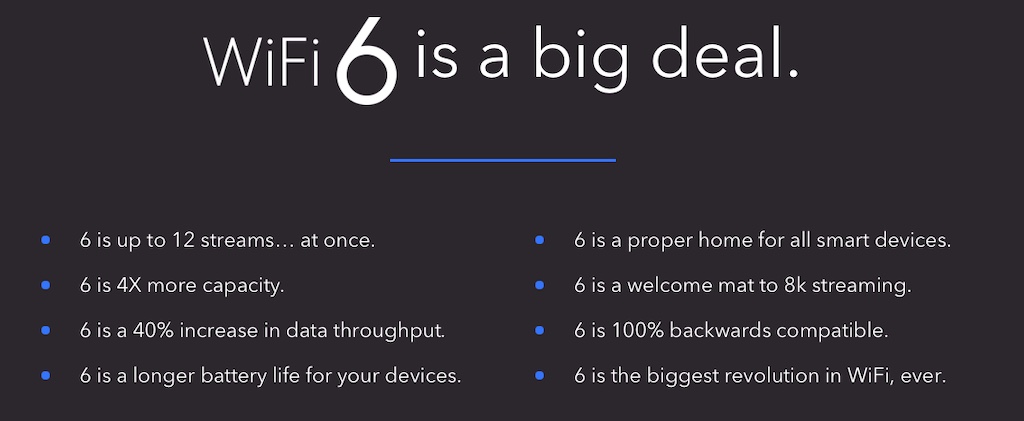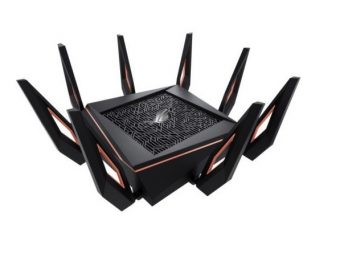
Are you ready to upgrade to Wi-Fi 6? The latest and greatest Wi-Fi standard is a pretty big deal—especially if your home is increasingly packed with Internet-connected smart devices. Haven’t heard of it? Not sure how Wi-Fi 6 compares to 802.11ac? Wondering what the heck happened to 802.11ax? I’ll try to answer all your questions, because Wi-Fi 6 is definitely something you should be aware of for your next Wi-Fi router to ensure you don’t have slow or intermittent Internet in your smart home.
Even if you don’t think so, chances are you have a smart home…
While households are increasingly adopting smart technology, not everyone is a fan. That’s understandable. Not everyone is interested in lights that can be programmed for cool sequences, the appeal of smart speakers or smart displays isn’t universal, and some people would prefer a lock and key to a connected smart lock on their door.
Even if you’ve avoided the “smart” wave, there’s a good chance that technically, you are still living in a smart home. Most TVs sold globally are smart TVs. If you own a video streamer like an Apple TV or Roku, that’s an Internet-connected “smart” device as well. The same with video game consoles. And odds are good you’ll also use other Internet-connected devices in your home, such as smartphones, tablets, and laptops.
Wi-Fi 6 may not dramatically help you immediately, but as those stealthily “smart” devices adopt Wi-Fi 6 themselves, then a Wi-Fi 6 router is going to make connectivity more stable and faster. You can learn more about how to get the right router for your home in this article on the blog.

Wi-Fi 6: faster, power-saving, and able to handle more connected devices
Wi-Fi 6 is the newest standard for Wi-Fi, and it uses a host of improvements that let it handle more devices connected simultaneously, while saving power and delivering an overall speed (or bandwidth) boost of up to a theoretical maximum of 10Gbps. This upgrade is aimed squarely at smart homes, where dozens of devices or more—smart cameras, door locks, thermostats, lights, smoke detectors, picture frames, and more—are competing for bandwidth. In extreme cases, these devices can overwhelm a Wi-Fi router’s ability to manage the traffic, resulting in devices dropping offline or suffering from laggy performance.
Here are some of the technologies in play with Wi-Fi 6.
QAM
QAM is technology that determines the amount of data a router can transmit at one time. 802.111ac used 256-QAM for 8 bits at once. Wi-Fi 6 uses 1024-QAM, allowing 10 bits to be transmitted at a time. More bits means more data, for greater speed.
OFDMA
OFDMA is a new development for Wi-Fi 6. It lets the router segment a wireless channel into smaller chunks, supporting more simultaneous connections and greater efficiency.
MU-MIMO
You’ve seen MU-MIMO before (it was a big benefit of 802.11ac). This technology lets a router target a device with a dedicated stream of data. It was one way (download only) with 802.11ac, but with Wi-Fi 6, MU-MIMO becomes bi-directional, supporting both downloads and uploads. And working together with OFDMA, MU-MIMO offers boosted response times and bandwidth for each of those dedicated streams.
Target Wake Time
There are a lot of smart devices that are battery-powered, especially sensors. With 802.11ac, they were constantly connected (or attempting to connect) to the router, draining battery life and adding to network congestion. Wi-Fi 6 introduces Target Wake Time, which lets sensors connect at scheduled times, reducing battery drain and preventing them from constantly hitting the network.
As with previous new Wi-Fi standards, Wi-Fi 6 is backwards compatible. This means that a Wi-Fi 6 router will still support devices using older versions of Wi-Fi.
What’s with the “6”?
One of the more confusing parts of this whole cycle is the change in naming convention. 802.11n versus 802.11ac never made much sense to most people, but 802.11ac to Wi-Fi 6 is even more confusing. Comparing “802.11ac” to “6” seems like trying to compare apples to oranges.
This was a decision on the part of the governing Wi-Fi Alliance to make the standards less confusing going forward. This latest version of Wi-Fi actually started life as 802.11ax. That became Wi-Fi 6, while the previous generation 802.11ac becomes Wi-Fi 5 and 802.11n becomes Wi-Fi 4. So a little head scratching right now, but going forward it will be a lot easier to tell at a glance whether a router or device supports the latest standard, and if not, how far out of date it is.
Should you buy a Wi-Fi 6 router now?

If you currently have an 802.11ac (or Wi-Fi 5, to use the new terminology) router and you’re happy with the performance of your home Wi-Fi network, there’s no need to rush out and upgrade to a new Wi-Fi 6 router. Your existing connected devices aren’t going to be able to take full advantage of the new router’s capabilities—that comes with devices that support Wi-Fi 6.
However, if you are currently shopping for a new router, one that supports Wi-Fi 6 wouldn’t be a bad idea. Even if none of your current devices support the new Wi-Fi standard, the router will be fully backwards compatible. And by going with Wi-Fi 6 now, you’ll be ready when your next smartphone, tablet, laptop, streamer, TV, or other device that can take advantage of Wi-Fi 6 arrives.
Don’t forget your ISP
As mentioned, one of the benefits of Wi-Fi 6 is a bump in data transfer speeds of up to 40% for a connected device. However, you should look at your ISP’s Internet plan as part of any upgrade. For example, if a Wi-Fi 6 smartphone connected to a Wi-Fi 6 router can download files at 1.3 Gbps compared to say 900 Mbs for a fast 802.11ac router, but your Internet speed is limited to 500 Mbps, then you won’t be seeing any of that speed increase. It’s always going to top out at 500 Mbps …
That being said, you would still enjoy the vastly superior traffic management of Wi-Fi 6.
If your home Wi-Fi isn’t as solid as you’d like, Best Buy has a huge selection of the latest Wi-Fi routers and whole home mesh Wi-Fi systems—including new models with Wi-Fi 6 support. And check out these helpful articles for more related information:




